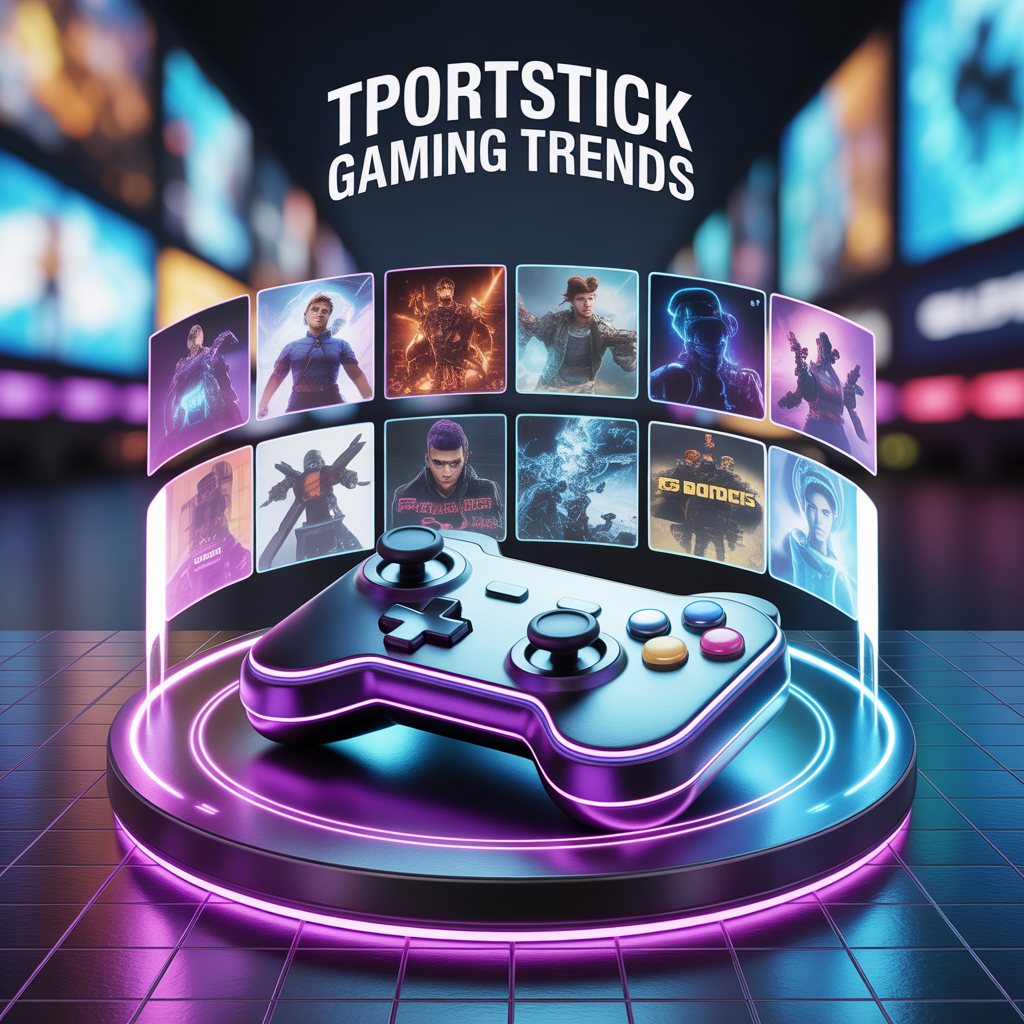The portable gaming landscape has undergone a seismic shift. What started as simple pixelated distractions has evolved into a multi-billion dollar ecosystem where Tportstick gaming trends are redefining how we play, connect, and immerse ourselves in digital worlds.
The Portable Gamer community isn’t just growing it’s exploding with innovation that challenges traditional console supremacy.
In 2025, mobile gaming evolution has reached unprecedented heights. Revenue from portable platforms now exceeds $180 billion annually, dwarfing traditional console markets.
This transformation isn’t accidental. It’s driven by five revolutionary forces: hyper-casual mechanics, cloud infrastructure, augmented reality integration, virtual reality accessibility, and facial recognition personalization.
Let’s dissect each trend with the depth it deserves.
Hyper-Casual Games: The Three-Minute Empire
Hyper-casual games represent the ultimate democratization of gaming. These titles strip away complexity, offering pure, unadulterated instant gratification that hooks millions within seconds.
The Formula That Prints Money
The mechanics couldn’t be simpler. One-touch controls. Vibrant colors. Immediate feedback loops.
Games like Flappy Bird, Helix Jump, and Paper.io mastered this approach, generating millions in revenue through volume rather than depth.
The average session lasts just 2.8 minutes, yet players return 8-12 times daily.
Key characteristics that define hyper-casual success:
- Minimalistic design that loads in under 3 seconds
- User-friendly controls requiring zero tutorial
- Achievement feedback loops triggering dopamine releases every 15-30 seconds
- Ad-based monetization supplemented by optional IAPs
- Session lengths optimized for commute windows and bathroom breaks
Real Market Performance
The numbers tell a compelling story. In Q4 2024, hyper-casual titles accounted for 78% of all mobile game downloads statistics, though only 31% of revenue.
This paradox reveals the strategy: chase scale, monetize through ads, convert 2-3% to paying users.
| Metric | Hyper-Casual | Mid-Core | Hardcore |
|---|---|---|---|
| Average Session | 2.8 min | 18 min | 47 min |
| Daily Sessions | 9.2 | 3.1 | 1.4 |
| Day 1 Retention | 42% | 28% | 18% |
| Day 30 Retention | 4% | 12% | 31% |
| ARPDAU | $0.04 | $0.18 | $0.87 |
The hyper-casual market share dominates discovery but loses players to deeper experiences after the initial honeymoon period.
Smart developers now blend casual entry points with hidden progression systems a trend Tportstick exemplifies perfectly.
Why Simple Works
Player motivation in hyper-casual gaming centers on habit formation. These games exploit micro-moments waiting for coffee, riding elevators, commercial breaks. They don’t compete with console epics; they fill gaps those games never could.
The psychology is deliberate. Bright colors trigger attention. One-touch controls eliminate friction.
Immediate scoring provides constant validation. It’s gamification stripped to its neurological core.
Cloud Gaming: Infrastructure Meets Imagination
Cloud gaming platforms promised to eliminate hardware barriers. The reality? More nuanced than marketing suggests, but genuinely transformative for specific use cases.
The Technical Reality Nobody Discusses
NVIDIA GeForce NOW, Xbox Cloud Gaming, and the late Google Stadia taught us hard lessons about latency and streaming optimization.
Competitive shooters remain challenging input lag averaging 67-124ms depending on server proximity makes frame-perfect timing impossible. But story-driven RPGs? They’re perfect.
Cloud-based gaming requirements break down like this:
- Minimum bandwidth: 15 Mbps for 1080p/30fps
- Recommended: 35 Mbps for 1080p/60fps
- Optimal: 50+ Mbps for 4K streaming
- Latency tolerance: Under 40ms for action games, under 80ms acceptable for turn-based
Data consumption during extended sessions runs high. A three-hour session at 1080p/60fps consumes roughly 9-12GB. Mobile gamers on capped data plans need to plan accordingly.
Where Cloud Gaming Actually Excels
The portable gamer ecosystem benefits enormously from cloud technology. Consider this scenario: You start Half-Life: Alyx on your desktop VR rig, continue on your tablet during lunch, then finish on your phone during your commute home. Cross-platform gaming seamlessly executed.
Subscription-based gaming models have stabilized pricing:
- Xbox Game Pass Ultimate (includes cloud): $16.99/month
- GeForce NOW Ultimate: $19.99/month
- PlayStation Plus Premium: $17.99/month
For players without $500-1500 gaming hardware, these services provide legitimate access to AAA experiences. The gaming without console revolution isn’t hype it’s here.
Augmented Reality Gaming: Beyond Pokémon GO’s Shadow
Augmented reality gaming suffered from the “one-hit wonder” problem. Pokémon GO exploded, then… what?
The answer took years to materialize, but AR technology has finally diversified.
Post-Pokémon Success Stories
Jurassic World Alive carved a niche with 25 million downloads and sustained engagement through competitive PvP elements.
Harry Potter: Wizards Unite underperformed expectations but proved AR storytelling could work with proper IP integration.
The lesson? AR community building requires more than location tagging it needs social incentives.
AR user engagement metrics reveal interesting patterns:
- Average session length: 12-18 minutes
- Weekly active users: 23% higher retention than standard mobile games
- Social connectivity in games: 67% of AR players engage in coordinated group activities
- Weather dependency: 42% drop in usage during rain/snow
The Technical Evolution
Modern AR in gaming leverages sophisticated motion tracking systems that previous generations couldn’t deliver. LiDAR-enabled smartphones create persistent augmented environments that remember physical spaces.
Your living room becomes a persistent battlefield that remembers furniture placement between sessions.
Real-world interaction through AR provides unique player engagement strategies:
- Geolocation-based events driving foot traffic to retail partners
- Environmental scanning creating custom level geometry
- Multiplayer environments overlaying shared virtual objects
- Gamification of fitness tracking and exploration
Battery drain remains the Achilles’ heel. AR sessions consume 8-12% battery per hour on modern devices acceptable for 90-minute sessions but prohibitive for marathon play.
Virtual Reality Gaming: Immersion Redefined
Virtual reality gaming occupies a fascinating position in the portable gaming trends landscape.
The Oculus Quest 2 proved standalone VR could work without PC tethering. The Quest 3 perfected it. PlayStation VR and HTC Vive serve different audiences with different expectations.
Hardware Evolution Creates New Possibilities
The VR adoption rate has accelerated dramatically. 2024 saw 14.2 million VR headsets sold globally up 67% from 2023.
Prices dropped while capabilities soared. The Quest 3 delivers impressive 360-degree virtual environments at $499, making premium immersive gaming experiences accessible.
| Headset | Resolution | FOV | Price | Wireless |
|---|---|---|---|---|
| Meta Quest 3 | 2064×2208/eye | 110° | $499 | Yes |
| PSVR2 | 2000×2040/eye | 110° | $549 | No |
| HTC Vive Pro 2 | 2448×2448/eye | 120° | $799 | Optional |
| Apple Vision Pro | 3660×3200/eye | 100° | $3499 | Yes |
VR storytelling has matured beyond tech demos. Games like Half-Life: Alyx proved AAA developers could create transformative narratives.
Horror titles exploit emotional immersion in ways flat screens never could. Your brain genuinely believes those zombies occupy your physical space.
The Barriers That Remain
Motion sickness in VR affects 25-40% of new users. Most adapt within 3-5 sessions, but that initial friction kills adoption for many.
Physical space requirements limit accessibility you need at least 6.5 feet x 6.5 feet for room-scale experiences.
Content drought persists. AAA VR in gaming titles arrive quarterly, not monthly. Development costs run 3-4x higher than traditional games due to 360-degree asset creation and playtesting complexity. Indies fill gaps, but major franchises remain hesitant.
Facial Recognition Gaming: Personalization Meets Privacy
Facial recognition gaming represents the most controversial gaming technology trends we’ll discuss. The potential?
Revolutionary gaming personalization and accessibility. The risks? Surveillance capitalism on steroids.
How It Actually Works
Modern facial recognition technology in gaming operates through two primary methods:
- Depth mapping using infrared sensors (more accurate, requires specialized hardware)
- 2D image analysis using front-facing cameras (universal but less precise)
Real-time rendering captures 43-68 facial landmarks, translating expressions into game inputs. Smile detection, emotion classification, even heart rate estimation through micro-expressions the technology feels simultaneously magical and unsettling.
Applications Beyond Avatar Creation
Avatar creation technology represents the obvious use case. Scan your face, generate your in-game character. But deeper applications show more promise:
- Dynamic storytelling that adapts based on emotional responses
- Emotion detection software adjusting difficulty when frustration peaks
- Accessibility in gaming for players with limited mobility
- AI-driven gaming experiences personalizing content delivery
The PBLinuxGaming Users community has been particularly vocal about implementing these features in open-source projects while maintaining data privacy in gaming. Their approach: process locally, store nothing, transmit zero biometric data.
The Privacy Calculus
Ethical gaming technology requires transparency. What data gets collected? Where’s it stored? Who accesses it? Most companies fail this test spectacularly.
Data security concerns in gaming escalate when biometric information enters the equation.
Unlike passwords, you can’t change your face. A breach exposing facial recognition data creates permanent security vulnerabilities.
Smart developers now offer emotion-based storytelling as opt-in features, processing data locally on devices like Abithelp Tablets without cloud transmission. This approach respects player agency while enabling innovation.
The Tportstick Philosophy: Integration Over Isolation
Tportstick gaming trends don’t exist in silos. The most exciting developments happen when these technologies converge.
Imagine: Cloud-streamed VR games with AR pass-through overlays, personalized through facial recognition, delivered via hyper-casual entry mechanics.
This isn’t science fiction. Early implementations already exist. The future of portable gaming lies in seamless technology integration that prioritizes user engagement over technical showcasing.
What This Means for Players
The Portable Gamer community benefits from increased accessibility. You don’t need $2000 hardware to experience cutting-edge games.
Cloud services democratize access. Mobile gaming trends continue pushing boundaries once exclusive to dedicated gaming PCs.
Gaming innovation accelerates when barriers fall. More players mean more feedback, faster iteration, better experiences. The cycle feeds itself.
Forward-Looking: 2025-2027 Predictions
Gaming trends 2025 suggest convergence across platforms. AR glasses with built-in cloud streaming. VR headsets with transparent AR modes. Facial recognition becoming standard input alongside controllers.
The gaming market statistics 2025 paint an optimistic picture:
- Total portable gaming revenue projected at $247 billion by 2027
- Cloud gaming market growth averaging 32% annually through 2026
- VR install base reaching 45 million households by end of 2026
- AR daily active users surpassing 280 million globally
Next-gen gaming technology will blur lines between portable and stationary experiences. Your phone becomes your console. Your glasses become your screen. Your expression becomes your controller.
The Bottom Line
Tportstick gaming trends represent more than technological curiosities. They’re reshaping how billions of humans spend leisure time.
The Portable Gamer isn’t a niche audience anymore it’s the mainstream.
These trends succeed because they solve real problems. Hyper-casual games fill micro-moments. Cloud gaming eliminates hardware gatekeeping. AR adds physicality to digital experiences.
VR delivers presence impossible otherwise. Facial recognition promises genuine personalization.
Challenges remain. Privacy concerns need addressing. Accessibility gaps require closing. Content quality must improve.
But the trajectory is clear: portable gaming has evolved from distraction to destination.
The gaming experience you’ll have in 2027 will look radically different from today.
The question isn’t whether these trends will dominate they already do. The question is how quickly you’ll adapt to this new reality.
Digital transformation in gaming doesn’t wait for permission. It simply happens.
Those who embrace these Tportstick gaming trends will ride the wave. Those who resist will wonder where gaming went without them.
The portable gamer revolution is here. Welcome to the future.
Read more knowledgeable blogs on Pun Dazzle

Philipp Engel is a passionate writer and pun lover dedicated to spreading laughter and joy through words. As the creator and author of the website Philipp Engel, he delivers a delightful mix of puns, jokes, and playful humor that entertains readers of all ages. With a sharp wit and a deep love for language, Philipp aims to brighten every visitor’s day with clever wordplay and a smile, making humor a universal language that connects people everywhere.








